Abstract
1. Nineteen healthy male volunteers participated in a double-blind, six-way, crossover study. With a separation of 1 week between sessions, volunteers received randomly one oral dose of each of the following compounds: 3 or 10 mg of the dopamine (DA2) receptor antagonist and serotonin (5HT1A) agonist DU 29894, 1 mg flesinoxan, 400 mg sulpiride, 3 mg haloperidol or placebo. 2. To assess the dopamine (DA2) antagonistic activity of the different compounds, plasma levels of prolactin were assessed at pre-dose, 0.5, 1, 2, 3, 4, 6 and 24 h post-dose. To assess the serotonin (5HT1A) agonistic activity, plasma levels of ACTH, cortisol and growth hormone were assessed at the same time-points as well as body temperature; the latter was also assessed 8 h post-dose. Plasma levels of DU 29894 were assessed at pre-dose and 2, 3, 4 and 24 h post-dose. 3. Sulpiride, haloperidol and both doses of 3 mg and 10 mg DU 29894 produced statistically significant increases in prolactin levels. The increase produced by 3 mg was roughly equivalent to that produced by 3 mg haloperidol whereas the increase produced by 10 mg DU 29894 was significantly larger. 4. Only 10 mg DU 29894 and 1 mg flesinoxan produced statistically significant increases in ACTH, cortisol and growth hormone. All compounds either showed a significant attenuation of the normal day time increase of body temperature (3 mg DU 29894, haloperidol and sulpiride) or a true significant decrease in body temperature (10 mg DU 29894 and flesinoxan).(ABSTRACT TRUNCATED AT 250 WORDS)
Full text
PDF
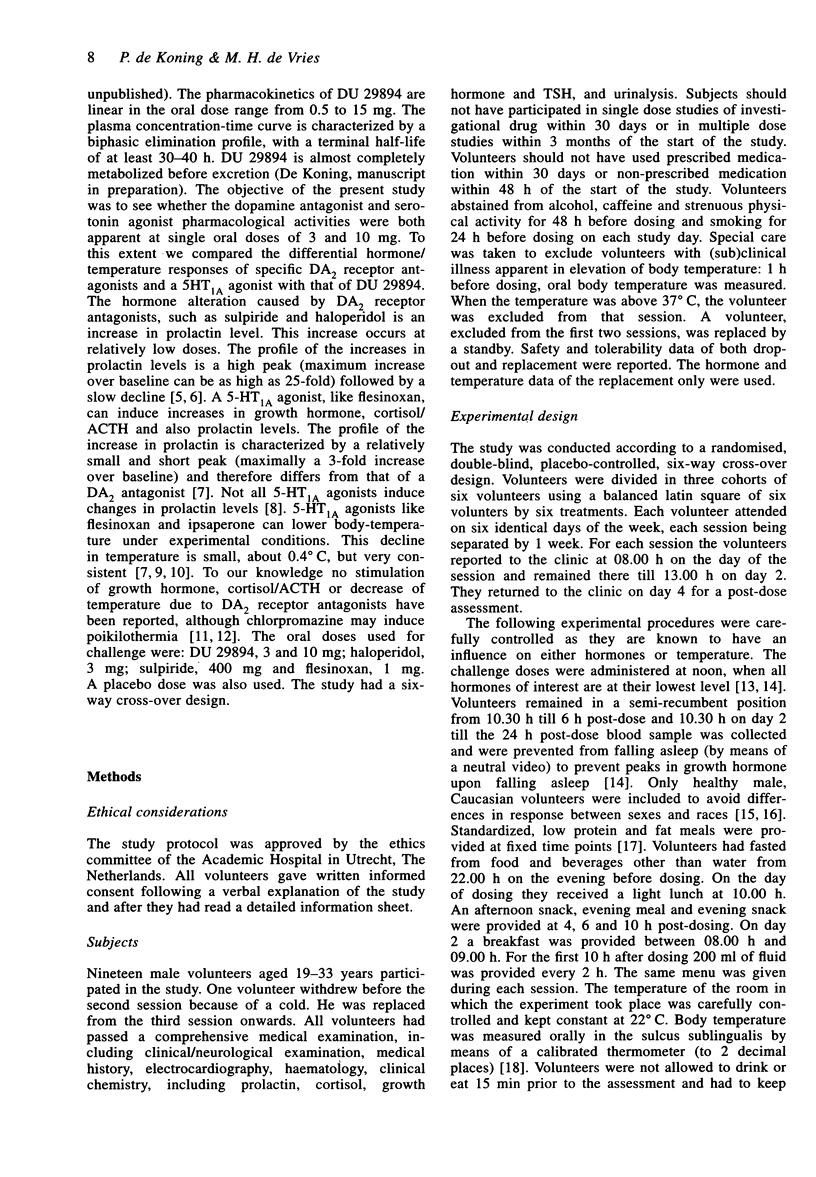
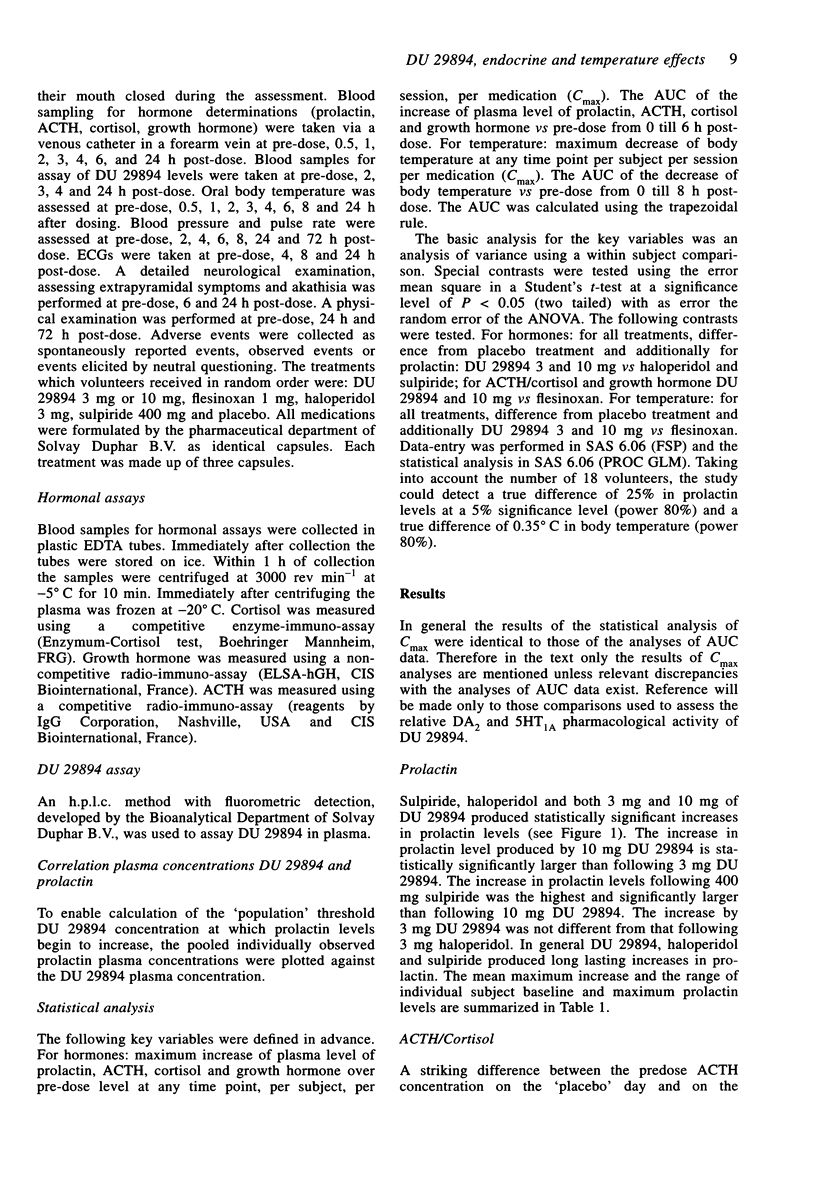
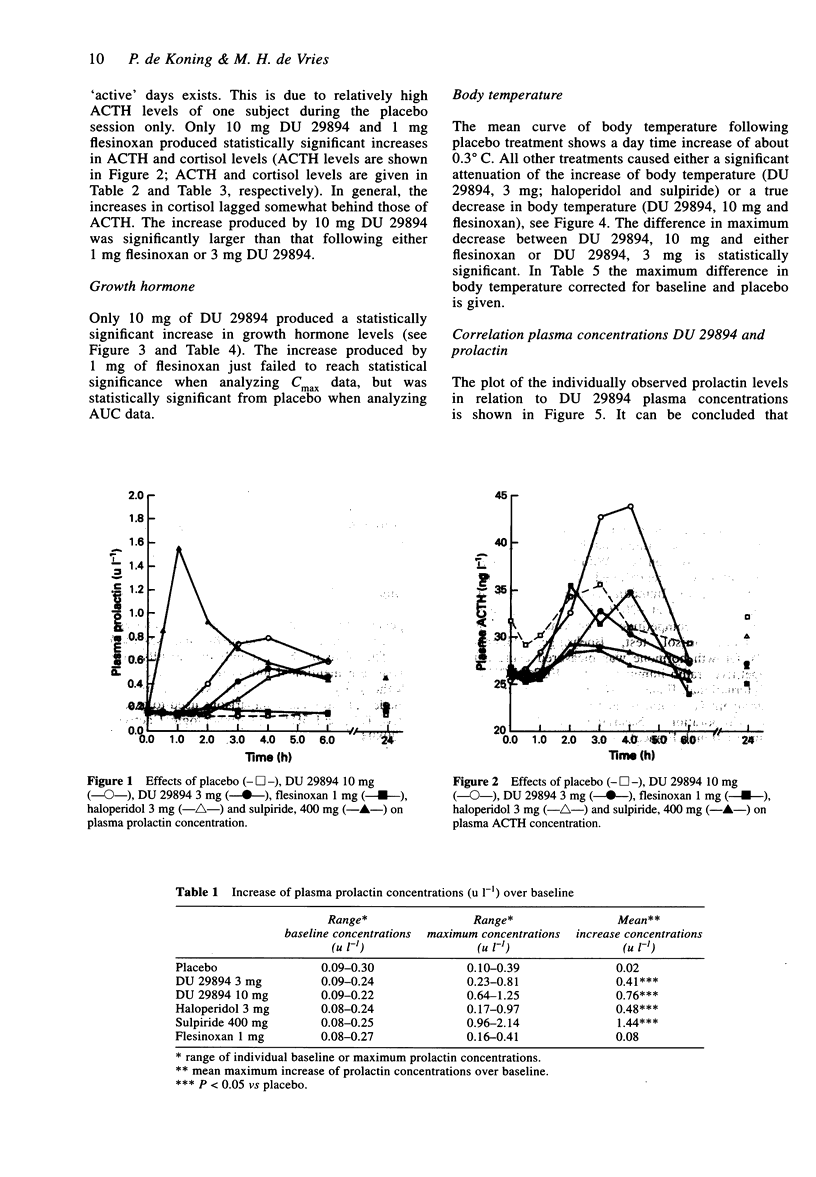
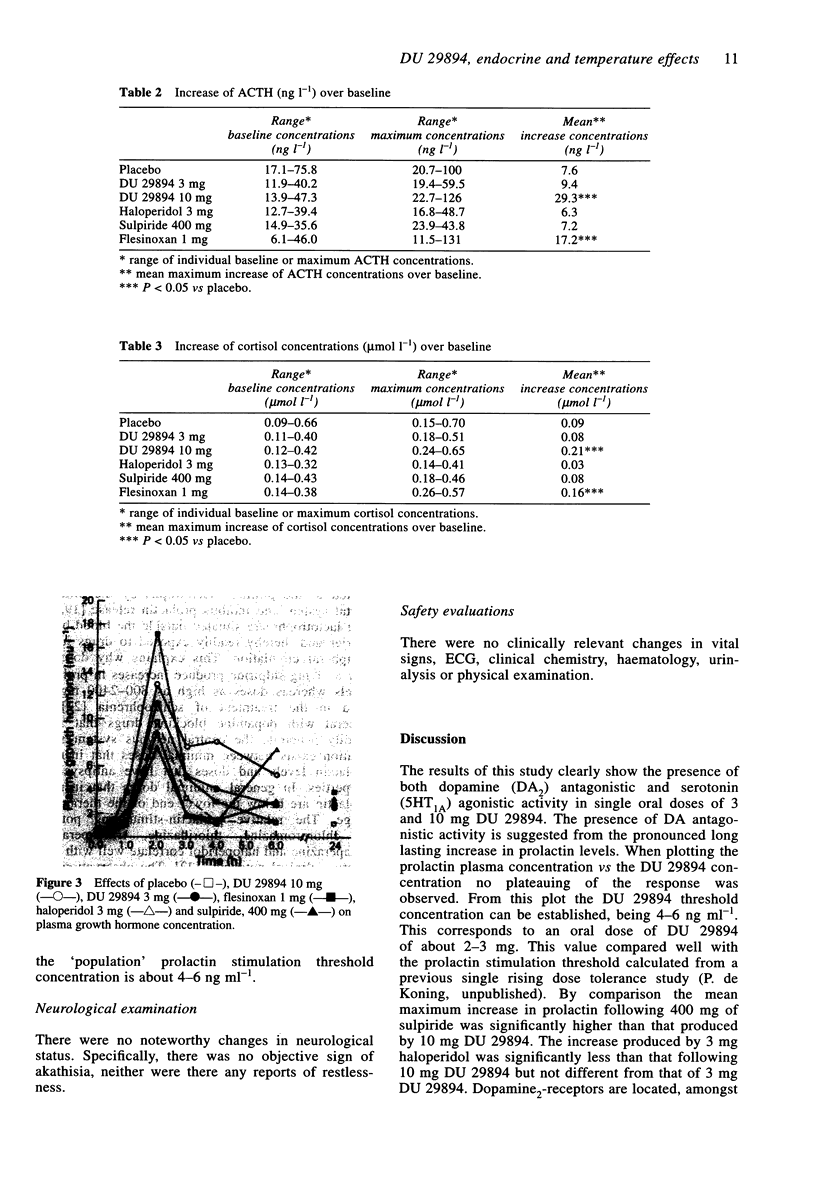


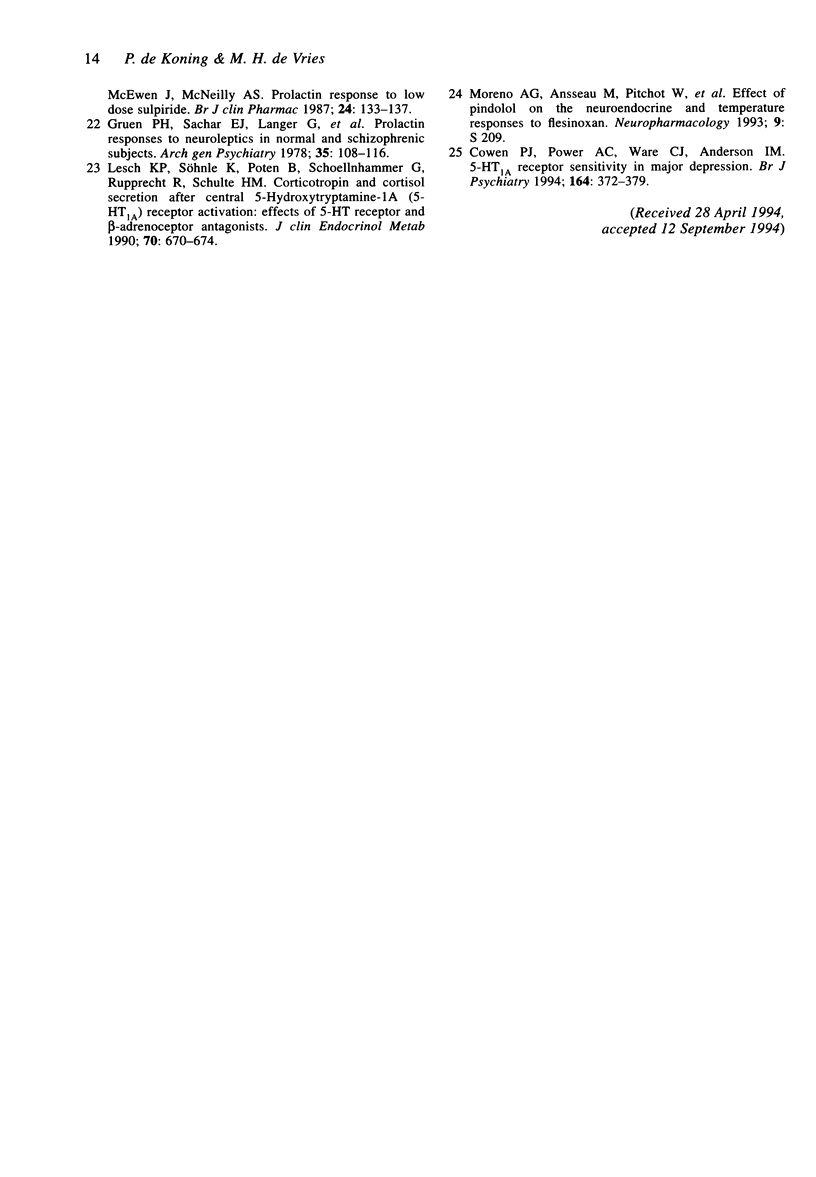
Selected References
These references are in PubMed. This may not be the complete list of references from this article.
- Acton G., Broom C. A dose rising study of the safety and effects on serum prolactin of SK&F 101468, a novel dopamine D2-receptor agonist. Br J Clin Pharmacol. 1989 Oct;28(4):435–441. doi: 10.1111/j.1365-2125.1989.tb03524.x. [DOI] [PMC free article] [PubMed] [Google Scholar]
- Anderson I. M., Cowen P. J., Grahame-Smith D. G. The effects of gepirone on neuroendocrine function and temperature in humans. Psychopharmacology (Berl) 1990;100(4):498–503. doi: 10.1007/BF02244002. [DOI] [PubMed] [Google Scholar]
- Canton H., Verrièle L., Colpaert F. C. Binding of typical and atypical antipsychotics to 5-HT1C and 5-HT2 sites: clozapine potently interacts with 5-HT1C sites. Eur J Pharmacol. 1990 Nov 20;191(1):93–96. doi: 10.1016/0014-2999(90)94100-c. [DOI] [PubMed] [Google Scholar]
- Cowen P. J., Power A. C., Ware C. J., Anderson I. M. 5-HT1A receptor sensitivity in major depression. A neuroendocrine study with buspirone. Br J Psychiatry. 1994 Mar;164(3):372–379. doi: 10.1192/bjp.164.3.372. [DOI] [PubMed] [Google Scholar]
- Grind M., Nilsson M. I., Nilsson L., Oxenstierna G., Sedvall G., Wahlén A. Remoxipride--a new potential antipsychotic compound. Tolerability and pharmacokinetics after single oral and intravenous administration in healthy male volunteers. Psychopharmacology (Berl) 1989;98(3):304–309. doi: 10.1007/BF00451679. [DOI] [PubMed] [Google Scholar]
- Gruen P. H., Sachar E. J., Langer G., Altman N., Leifer M., Frantz A., Halpern F. S. Prolactin responses to neuroleptics in normal and schizophrenic subjects. Arch Gen Psychiatry. 1978 Jan;35(1):108–116. doi: 10.1001/archpsyc.1978.01770250110011. [DOI] [PubMed] [Google Scholar]
- Gruen P. H., Sachar E. J., Langer G., Altman N., Leifer M., Frantz A., Halpern F. S. Prolactin responses to neuroleptics in normal and schizophrenic subjects. Arch Gen Psychiatry. 1978 Jan;35(1):108–116. doi: 10.1001/archpsyc.1978.01770250110011. [DOI] [PubMed] [Google Scholar]
- Ishizuka B., Quigley M. E., Yen S. S. Pituitary hormone release in response to food ingestion: evidence for neuroendocrine signals from gut to brain. J Clin Endocrinol Metab. 1983 Dec;57(6):1111–1116. doi: 10.1210/jcem-57-6-1111. [DOI] [PubMed] [Google Scholar]
- Lesch K. P., Rupprecht R., Poten B., Müller U., Söhnle K., Fritze J., Schulte H. M. Endocrine responses to 5-hydroxytryptamine-1A receptor activation by ipsapirone in humans. Biol Psychiatry. 1989 Jun;26(2):203–205. doi: 10.1016/0006-3223(89)90024-3. [DOI] [PubMed] [Google Scholar]
- Lesch K. P., Söhnle K., Poten B., Schoellnhammer G., Rupprecht R., Schulte H. M. Corticotropin and cortisol secretion after central 5-hydroxytryptamine-1A (5-HT1A) receptor activation: effects of 5-HT receptor and beta-adrenoceptor antagonists. J Clin Endocrinol Metab. 1990 Mar;70(3):670–674. doi: 10.1210/jcem-70-3-670. [DOI] [PubMed] [Google Scholar]
- Lesch K. P., Wiesmann M., Hoh A., Müller T., Disselkamp-Tietze J., Osterheider M., Schulte H. M. 5-HT1A receptor-effector system responsivity in panic disorder. Psychopharmacology (Berl) 1992;106(1):111–117. doi: 10.1007/BF02253597. [DOI] [PubMed] [Google Scholar]
- Lin K. M., Poland R. E., Lau J. K., Rubin R. T. Haloperidol and prolactin concentrations in Asians and Caucasians. J Clin Psychopharmacol. 1988 Jun;8(3):195–201. [PubMed] [Google Scholar]
- McMurdo M. E., Howie P. W., Lewis M., Marnie M., McEwen J., McNeilly A. S. Prolactin response to low dose sulpiride. Br J Clin Pharmacol. 1987 Aug;24(2):133–137. doi: 10.1111/j.1365-2125.1987.tb03153.x. [DOI] [PMC free article] [PubMed] [Google Scholar]
- Müller E. E., Locatelli V., Cella S., Peñalva A., Novelli A., Cocchi D. Prolactin-lowering and -releasing drugs. Mechanisms of action and therapeutic applications. Drugs. 1983 Apr;25(4):399–432. doi: 10.2165/00003495-198325040-00004. [DOI] [PubMed] [Google Scholar]
- Slot A. Verschillen tussen orale, axillaire en rectale temperatuurmeting in het traject 36,5-40,5 graden C. Ned Tijdschr Geneeskd. 1984 Oct 20;128(42):1983–1985. [PubMed] [Google Scholar]
- Vogel H. P., Kroll M., Fritschka E., Quabbe H. J. Twenty-four-hour profiles of growth hormone, prolactin and cortisol in the chronic vegetative state. Clin Endocrinol (Oxf) 1990 Nov;33(5):631–643. doi: 10.1111/j.1365-2265.1990.tb03902.x. [DOI] [PubMed] [Google Scholar]
- Weltzin T. E., McConaha C., McKee M., Hsu L. K., Perel J., Kaye W. H. Circadian patterns of cortisol, prolactin, and growth hormonal secretion during bingeing and vomiting in normal weight bulimic patients. Biol Psychiatry. 1991 Jul 1;30(1):37–48. doi: 10.1016/0006-3223(91)90068-w. [DOI] [PubMed] [Google Scholar]
- Wiesel F. A., Alfredsson G., Ehrnebo M., Sedvall G. Prolactin response following intravenous and oral sulpiride in healthy human subjects in relation to sulpiride concentrations. Psychopharmacology (Berl) 1982;76(1):44–47. doi: 10.1007/BF00430753. [DOI] [PubMed] [Google Scholar]
- von Bahr C., Wiesel F. A., Movin G., Eneroth P., Jansson P., Nilsson L., Ogenstad S. Neuroendocrine responses to single oral doses of remoxipride and sulpiride in healthy female and male volunteers. Psychopharmacology (Berl) 1991;103(4):443–448. doi: 10.1007/BF02244242. [DOI] [PubMed] [Google Scholar]


